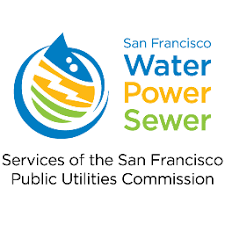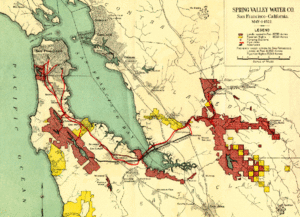San Francisco Public Utilities Commission facts for kids

SFPUC logo
|
|
| Agency overview | |
|---|---|
| Formed | 1932 |
| Jurisdiction | City and County of San Francisco |
| Headquarters | 525 Golden Gate Ave., San Francisco, CA 94102 |
| Employees | ~2,700 |
| Annual budget | $3.5 billion USD (operating and capital combined, 2023-24) |
| Agency executive |
|
| Website | sfpuc.gov |
The San Francisco Public Utilities Commission (SFPUC) is a public agency in San Francisco, California. It provides important services like water, wastewater (sewage), and electricity to the city. The SFPUC also supplies water to about 1.9 million people in three other counties around the San Francisco Bay Area.
Contents
What the SFPUC Does
The SFPUC manages a huge system that brings water to homes and businesses. This system includes reservoirs, tunnels, pipelines, and special cleaning facilities. It is one of the largest public utility agencies in California.
Providing Clean Water
The SFPUC gets fresh water from places like the Hetch Hetchy Reservoir. It delivers this water to 2.7 million customers for their homes, businesses, and industries. About one-third of the water goes to San Francisco itself. The other two-thirds go to customers in Alameda, San Mateo, and Santa Clara counties.
Generating Clean Power
The SFPUC has been providing clean electricity for over 100 years. It started by generating power using water to help build the O'Shaughnessy Dam. The SFPUC has two main power programs: Hetch Hetchy Power and CleanPowerSF.
Hetch Hetchy Power creates and delivers electricity that produces no greenhouse gases. It powers over 6,300 places, including city buildings like San Francisco General Hospital and the San Francisco International Airport. It also powers schools, libraries, and the Muni transit system. Some homes and businesses, including affordable housing, also get electricity from Hetch Hetchy Power.
The SFPUC also runs CleanPowerSF. This program lets people choose cleaner electricity options. Together, these two power programs provide more than 75% of San Francisco's electricity. In 2023, these programs helped customers save over $170 million on their electricity bills compared to other companies.
Managing Wastewater
The SFPUC also handles San Francisco's wastewater system. This system collects and treats both sewage and stormwater (rainwater that runs off streets). After cleaning, the treated water is released into the San Francisco Bay and the Pacific Ocean.
The Southeast Water Pollution Control Plant treats about 80% of the city's wastewater. The Oceanside Water Pollution Control Plant handles the remaining 20%. There's also a third facility, the North Point Wet-Weather Facility. It only works during heavy rain to clean combined sewage before it goes into the San Francisco Bay.
How the SFPUC Started
In the mid-1800s, a private company called the Spring Valley Water Company (SVWC) owned most of the water sources in Alameda County. This company had control over water service in San Francisco.
In 1906, a major owner of the SVWC, William Bowers Bourn II, hired an architect named Willis Polk. He wanted Polk to design a "water temple" where three large underground water pipes met. These pipes brought water from different creeks and wells.
For many years, people in San Francisco wanted the city to buy the SVWC. They felt the price was too high in 1873 when the first attempt was made. However, some believe Bourn, who came from a wealthy family, also cared about helping the city.
Before the Hetch Hetchy Aqueduct was finished in 1934, about half of San Francisco's water passed through the Sunol Water Temple. The city of San Francisco bought the SVWC, including the temple, in 1930 for $40 million.
In 1932, San Francisco created a new city plan that officially started the San Francisco Public Utilities Commission. When it first began, the SFPUC was in charge of the Hetch Hetchy Project, the San Francisco Municipal Railway (Muni), the Water Department, and the Airport. Later, the Airport became its own commission in 1971. In 1994, Muni also became a separate transportation commission.
How the SFPUC is Organized
The SFPUC is led by a group of five Commissioners. The Mayor of San Francisco chooses these Commissioners, and the San Francisco Board of Supervisors must approve them. Each Commissioner is chosen for a specific reason:
- One member has experience with environmental policy and understanding environmental fairness.
- Another member has experience helping customers or consumers.
- A third member has experience with how projects are paid for.
- The fourth member is an expert in water systems, power systems, or managing public utilities.
- The fifth member is chosen from the general public.
The Commissioners meet twice a month. Their job is to oversee how the SFPUC operates. This includes approving prices for services, approving contracts, and setting rules for the organization.
The Commissioners also choose a General Manager to be the main leader of the SFPUC. Each main part of the SFPUC is led by an Assistant General Manager. These six main parts are: Business Services, External Affairs, Infrastructure, Power Enterprise, Water Enterprise, and Wastewater Enterprise.
Caring for the Environment
San Francisco wants to become a "zero emission city" by 2030. To help with this, the SFPUC is working on many projects to improve how sustainable its water, power, and sewer services are.
- Water: The SFPUC has a "Water System Improvement Program" (WSIP). This program focuses on making pipelines, pump stations, and water tanks work as well as possible.
- Power: The SFPUC creates and provides different types of clean energy. This includes hydroelectric (from water), solar, and biogas (from waste). This clean energy is used for city services and for citizens. The SFPUC is also working with a company called Paradox Engineering. They are exploring how streetlights can be used to monitor city services and save energy.
- Sewer: The SFPUC has a "Sewer System Improvement Program" (SSIP). This program works on improving pump stations and how wastewater is treated. The SFPUC has also invested over $50 million in projects to test "Low Impact Designs" (LID). These designs, like bio-retention systems, help reduce the amount of stormwater that goes into the sewer system. By reducing stormwater, less energy is needed to treat the wastewater.
The SFPUC is also working to fix sewage flooding in several neighborhoods in San Francisco. These low-lying areas near the San Francisco Bay can flood during winter storms. As the land sinks, sea levels rise, and cities grow, managing runoff and sewage will continue to be a challenge.
Related Topics
- Hetch Hetchy
- Sunol Water Temple - a unique building owned by the SFPUC
- Pulgas Water Temple - a building similar to the Sunol Water Temple
- Crystal Springs Park, California
- Dutch Windmill (Golden Gate Park)
- Murphy Windmill
- Charles N. Fox
- Michael O'Shaughnessy
- Hermann Schussler
- Lloyd Tevis
- Antoine Borel
- Ethel Grace Lynn


